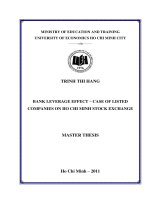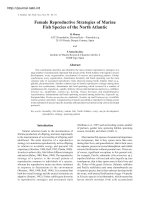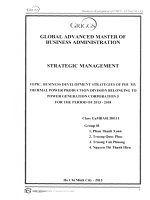E-Learning Strategies of Italian Companies
Bạn đang xem bản rút gọn của tài liệu. Xem và tải ngay bản đầy đủ của tài liệu tại đây (1.1 MB, 34 trang )
E-Learning Strategies of Italian Companies 171
Copyright © 2005, Idea Group Inc. Copying or distributing in print or electronic forms without written
permission of Idea Group Inc. is prohibited.
Chapter VIII
E-Learning
Strategies of Italian
Companies
Anna Comacchio, University of Ca' Foscari, Italy
Annachiara Scapolan, University of Ca' Foscari, Italy
Abstract
The chapter gives a contribution to the understanding country-
specific e-learning models, focusing on the e-learning experience of
Italian companies in the pharmaceutical and banking industries. The
chapter analyzes the antecedents of a corporate e-learning adoption
process, asking whether it is forced by the rational search for economic
benefit, or by bandwagon pressures, whereby companies are more interested
in their reputations. The chapter also aims at understanding how companies
are implementing e-learning, analyzing the most important features of the
e-learning strategies: users, contents, infrastructures, and services and
supports. After having discussed the result of the research conducted on
a document analysis, a survey, some interviews, and two in-depth case
172 Comacchio & Scapolan
Copyright © 2005, Idea Group Inc. Copying or distributing in print or electronic forms without written
permission of Idea Group Inc. is prohibited.
studies, the emerging B2E strategy for e-learning is explained. In the
conclusions the main issues related to the e-learning processes in the
Italian companies are summarized, and the research methodology and the
possible future research lines are discussed.
Introduction
In recent years, corporate e-learning has been the subject of several studies.
On the one hand, it has been identified as one of the latest best practices in HRM
(Nacamulli, 2003) because it enables companies to meet new intellectual
capital investment requirements (ASTD, 2001). These include the need to
enhance quality and effectiveness in program development while reducing
costs, to update the skills base throughout the organization (at all levels, across
a wide geographical area, etc.), and to increase the organization’s learning
capability by integrating online training and strategic knowledge management
(Ley & Ulbrich, 2002).
On the other hand, due to the exponential rate at which this innovation was
adopted in the USA, in the last years the experience of pioneers, in both the
public and private sectors, and their best practices have become one of the main
issues dealt with in corporate e-learning research and literature (Shank, 2002;
Horton, 2001; Rosenberg, 2001).
However, corporate e-learning is not spreading worldwide as fast as expected,
and it is far from being applied extensively in Europe and Italy, despite a number
of enthusiastic forecasts (Anee, 2003; IDC, 2002). Furthermore, if we look at
companies’ e-learning experiences, it appears that organizations are ap-
proaching it in an incremental and experimental manner. Among other explana-
tions, three factors (partially related) can help to understand this controversial
rate of diffusion. First of all, many benefits promised on paper are not what e-
learning is really providing (Prandstraller, 2001). Secondly, even if the stan-
dardization process does seem to simplify the identification of some main
features of a corporate e-learning strategy, it is still rather difficult to relate them
to ROI. Thirdly, technological and organizational best practices are not simply
introduced as they are by companies, but adoption of best models is a learning
process and depends on specific organizational capabilities such as absorptive
capacity (Martin, Robson, & Jennings, 2002; Cohen & Levinthal, 1990).
E-Learning Strategies of Italian Companies 173
Copyright © 2005, Idea Group Inc. Copying or distributing in print or electronic forms without written
permission of Idea Group Inc. is prohibited.
These considerations suggest that the study of e-learning should take a more in-
depth view of the ways it is adopted and of the context-related factors that,
nationally and within organizations, may promote or prevent it and influence the
way companies implement corporate e-learning.
From this perspective, the chapter aims to give a contribution to understanding
the e-learning adoption process in Italy. First of all, the chapter will focus on
what makes a company adopt e-learning, asking whether it is forced to by the
rational search for economic benefit, or by institutional pressures whereby
companies are more interested in their reputation and image. The adoption
process will be analyzed, considering who the decision makers are in compa-
nies, the main sources of information, and the perceived and achieved organi-
zational aims.
Secondly, the chapter will contribute to understand how companies are
implementing e-learning and the main issues related to this process. From an
organizational point of view, it will analyze the main features of the e-learning
strategies that are emerging in Italian companies.
Since the spread of e-learning in Italy is in its infancy, research has been
undertaken in two industries — pharmaceuticals and banking — where e-
learning has been adopted more extensively than in others, and where both
companies with very early and more advanced experiences can be analyzed.
An empirical study has been developed in each industry based on a survey,
interviews, and document analysis.
Corporate E-Learning: How Companies
Adopt It
Corporate E-Learning and Its Main Drivers
Corporate e-learning can be defined as an extensive computer and Internet-
based method (Piskurich, 2003) for a company’s training and development
policies.
Today’s new browser-based HR portal technology is changing the way
organizations manage human resources (Walker, 2001), specifically the way
firms train their employees. The debate around this latest killer application of
174 Comacchio & Scapolan
Copyright © 2005, Idea Group Inc. Copying or distributing in print or electronic forms without written
permission of Idea Group Inc. is prohibited.
ICT, as John Chamber, Cisco CEO, has defined it, has contributed to the
knowledge about e-learning being codified, by updating common languages
and frames of reference. Networks of research projects, consultants, and
companies continuously rationalize experiences at a national and company
level, comparing different alternatives and building common theoretical as-
sumptions on e-learning strategy (Nacamulli, 2003; Cunningham, 2001;
Rosenberg, 2001). Researchers and practitioners mainly agree that by invest-
ing in e-learning, companies try to gain three types of benefits (Hartley, 2003;
Shank, 2002):
1. Streamlining learning processes through cost savings (instructional
costs, opportunity costs, administrative costs, travel costs, scalability
resulting from the repeatability of courses or modules). Cost reduction
and flexibility can be achieved in many ways, mainly by choosing the level
of interactivity and cooperation of a learning experience and its
synchronicity or asynchronicity.
2. Quality and effectiveness of learning through flexibility (just-in-time
access to knowledge/information) and by tailoring time, methods, and
content of courses to work requirements and learning by doing.
Figure 1. Benefits of e-learning
Service
&
Infrastr.
cture
Content
s
Users
E-LEARNING SOLUTION
Quality and
Effectiveness of
learning
Motivation and
retention of talented
employees
Streamlining learning
process
E-Learning Strategies of Italian Companies 175
Copyright © 2005, Idea Group Inc. Copying or distributing in print or electronic forms without written
permission of Idea Group Inc. is prohibited.
3. Motivation and retention of talented employees through customization
and learning on demand. The delivery of online courses fitting personal
learning style seems to enhance the learning experience. Learning on
demand and free choice of courses may also develop employees’ employ-
ability.
Recent debate is questioning why these benefits are not accomplished yet, why
there are more failures than successes in achieving economic and quality
benefits (Prandstraller, 2001). One main question to address is that the
adoption of e-learning is not a rational choice but an ambiguous decision
process, characterized by “opaqueness or lack of clarity surrounding an
organizational assessment of an innovation” (Abrahamson & Rosenkopf,
1993, p. 494). As a company cannot evaluate the technical efficiency or the
returns of an innovation, because of ambiguity of goals, of means-end relation-
ships, and environment (March & Olsen, 1976), it will rely more on social as
opposed to economic factors, in order to decide whether to adopt an
innovation or not.
Considering the innovation of e-learning, we may find that ambiguity does
matter. Doubtless there is a codification of best practices process going on
within the international e-learning marketplace. It is driven by academic studies,
research centers (Astd, Idc, Masie, etc.), and providers, and it is also
facilitated by the actions of standardizing groups (AICC, IEEE Ltsc, EU
Ariadne project, ADL) (Rosenberg, 2001) and by the emergence of shareable
courseware object reference models (reusable learning objects). This codifi-
cation process of e-learning best practices seems to make it easier to identify
both strategies’ dimensions and advantages. Considering this process, mana-
gerial literature and research centers (Astd, Masie, IDC) maintain that a
company can rationally identify the best e-learning model and decide which to
adopt after evaluating the ROI of this type of investment. But even if the
standardization process does seem to help companies identify some main
features of an e-learning solution and its main benefits, it is still rather difficult
to relate them to economic performance.
First of all, it appears that companies are suffering from ambiguity of goals,
especially in the early-stage adoption. Considering the Italian context as an
example of early-stage adoptions, results of research into e-learning in Italy in
2002 by A.D. Little 2002 highlighted that, while companies seem mainly
efficiency driven, when they choose an e-learning solution, their decision
process is far from being rational. Companies do not plan the adoption of e-
176 Comacchio & Scapolan
Copyright © 2005, Idea Group Inc. Copying or distributing in print or electronic forms without written
permission of Idea Group Inc. is prohibited.
learning taking into consideration each phase of the introduction process and
do not specify the related objectives and measurements of performance.
Secondly, considering the type of innovation e-learning triggers, ambiguity of
means-ends relations has an effect. E-HRM policies like e-learning should be
considered more than just a simple technological change of people management
tools and more than online delivery of HR services (Hansen & Deimler, 2001).
From this point of view, firstly, e-learning adoption implies not only technologi-
cal but also organizational changes and, secondly, for this reason, their impact
on efficiency could be less clear. Quality results can be achieved by CBT
asynchronous courses, but also by blended solutions. Moreover, even though
some indicators of efficiency and also of effectiveness of training are widely
adopted (Kirkpatrick, 1998), individual learning processes are “soft” issues.
Their results are mainly of an intangible nature, and even though skill or
competency development can be achieved and partially measured, it is rather
difficult to isolate its impact on job performance and individual motivation from
several other causes. It is also more difficult to measure increased employability
that people can gain thanks to online training. For this reason measurements are
not univocally quantifiable, related indicators have an ambiguous meaning, and
the evaluation process is still time consuming and costly. Thus, the adoption
process of e-learning could be difficult to evaluate on a traditional basis
(Schank, 2002).
Under these conditions, companies rely more on information about who has
adopted an innovation (Abrahamason & Rosenkopf, 1997). Moreover, adopt-
ers choose an innovation because of the threat of lost legitimacy under
institutional bandwagon pressure. Recent studies of the managerial best
practices (e.g., quality management or teamwork) (Staw & Epstein, 2000)
demonstrated that what forces the adoption of a new organizational solution is
the pursuit of reputation within a social and cultural environment (DiMaggio &
Powell, 1983; Granovetter, 1985).
E-learning is a particularly relevant innovation from a corporate point of view.
For example, it impacts on the issue of lifelong learning, which is one of the
priorities of the EU (2003), national governments, trade unions, and training
institutions. Furthermore, the flexibility and the connectivity of such solutions
facilitate remote learning from home, and this is an important issue for
workforce retraining from a trade union point of view. From this perspective,
as e-learning impacts on the investment in human capital and lifelong learning,
it may attract the attention of institutions operating in the labor market such as
unions, training associations, and public institutions. Secondly, companies seek
E-Learning Strategies of Italian Companies 177
Copyright © 2005, Idea Group Inc. Copying or distributing in print or electronic forms without written
permission of Idea Group Inc. is prohibited.
standardized responses to cope with uncertainty related to innovation. They do
this by imitating those organizations that, thanks to their competitive capabilities
or their international dimensions, are considered a reference model (for
example, Cisco is often referred to as a benchmark in E-HRM and e-learning
in many conferences, studies, and consultants’ reports) (Haberberg & Binsardi,
2002). Finally, the managers’ choice of e-learning is influenced by the profes-
sional community with which they share common learning paths and the same
social networks (Haberberg & Binsardi, 2002).
When the adoption process is uncertain and results are ambiguous, there might
also be competitive bandwagon pressures towards the introduction of an e-
learning strategy by companies (Abrahamson & Rosenkopf, 1993, 1990).
Companies will adopt innovations because of the threat of lost competitive
advantage. Bandwagons occur if potential adopters perceive the risk that an
innovation is a success and that if they do not adopt it, their performance will
fall below the average performance of adopters.
From a bandwagon perspective, benefits like cost cutting, scalability, and
flexible delivery of skill training to a spread number of trainees can be easily
communicated because they are measurable in the short term and quantifiable,
and so are perceived as a threat of a competitive disadvantage. If this threat,
in the utility scheme of companies, outweighs the perceived value of an equally
large competitive advantage (Abrahamson & Rosenkopf, 1993), bandwagon
pressures exceed the company’s adoption threshold — that is, a company’s
reluctance in the face of innovation and change.
E-Learning in Italy and the Adoption Process
As discussed previously, institutional and competitive bandwagon pressures
may be main determinants of e-learning adoption. In the following paragraphs
we will also concentrate on the knowledge creation process related to an
adoption process. We will discuss how external pressures are translated within
an organization in company-specific solutions, by analyzing four main dimen-
sions of a corporate e-learning strategy: content delivered (asyncronicity,
learning object, information, knowledge, and competency issues), infrastruc-
ture (learning portal, authoring system, LMS, interoperability issues), users
(issues related to the role of HRM, push or pull learning, learners’ problems,
and motivation), and services and supports (tutoring, tracking functions,
feedback, culture building, etc.).
178 Comacchio & Scapolan
Copyright © 2005, Idea Group Inc. Copying or distributing in print or electronic forms without written
permission of Idea Group Inc. is prohibited.
Empirical Research: Research Design and the Sample
The research presented in this section focuses on two industries — pharmaceu-
tical and banking — that both have undergone significant changes in recent
years. Considering the competitive environment of the two industries, which
were highly protected until a few years ago, they have both been caught up by
new challenges like technological innovations, deregulation, globalization, and
M&A. On the one hand, both types of companies have been forced to
reorganize their structures (making them flatter and decentralized) and to
manage more efficiently and effectively their supply chain processes as well as
staff services like human resource management policies. On the other hand, in
order to increase their response to the market and competitors, they have been
induced to reskill their workforce, thereby increasing their investment in human
capital (for instance, those staff who deal with end customers). For these
reasons the two industries are among those in Italy where e-learning seems to
be widespread (Anee, 2001), and where both early and more advanced
experiences can be studied. Another reason to study them is their different
institutional contexts, especially from an industrial relations point of view. This
aspect matters if we consider institutional pressures as determinants of e-
learning adoption.
The empirical study has been developed on a survey, interviews, and document
analysis. The survey was conducted through structured questionnaire e-mailed
to the main companies in both sectors between September and December
2002.
1
Some interviews of HRM managers of leading companies in the two
industries were conducted before and after the survey, in order to prepare the
cross-sectional analysis, to assess triangulating sources of data, and to develop
some case studies. Two cases (Unicredit and BPM) are discussed in the
following sections. Finally, document analysis was carried out on collective
agreements and on a secondary source of data provided by ABI (the Italian
association of banks).
The pharmaceutical sample
2
includes 20 organizations, both multinational and
Italian, and represents both large and medium-sized companies. Five of the
companies interviewed (25%) belong to the top 10 pharmaceutical companies
in Italy.
The banks
3
surveyed include 22 companies: both large banking groups and
very small banks like cooperative banks. Six of the companies interviewed
(27%) belong to the top 10 banks in Italy.
E-Learning Strategies of Italian Companies 179
Copyright © 2005, Idea Group Inc. Copying or distributing in print or electronic forms without written
permission of Idea Group Inc. is prohibited.
Adoption Decisions
We started our analysis by looking at the rate of adoption of e-learning in
relation to the different institutional and competitive bandwagon pressures that
characterize the two industries.
With regards to labor market institutions in the pharmaceutical industry, even
though the national collective contract (CCNL) mentions “the arrangement
of remote training modules on subjects specific to workers of the pharma-
ceutical industry,” and since the end of 2002 the Bilateral National Organi-
zation (created by the same CCNL) has had the task of investing in lifelong
training of employees, e-learning is not explicitly taken into account by the
agreement between employers’ associations and unions. Besides, the national
employers’ association (Federchimica) has not yet adopted policies or realized
activities aimed at promoting or studying e-learning. These considerations lead
to the conclusion that regulatory institutional pressures are rather low in the
pharmaceutical industry.
In the banking sector, by contrast, the use of e-learning for continuous training
is recognized by the labor market’s institutions. First of all, the CCNL says that
continuous training of personnel is an essential tool for developing human
capital, and it has a strategic role in the transformation of the banking system.
For this reason the collective contract states that the Bilateral National
Organization has the task of promoting training by applying for European,
national, and regional funds. It also states that from the year 2000, banks have
to provide all employees with not only a fixed amount of training hours during
working time, but also 26 hours per year spare time “through self-training using
appropriate computing tools”. Furthermore, the employers’ association is
promoting e-learning adoption through its training company (ABIFormazione),
which is also one of the main e-learning providers in the banking industry.
ABIFormazione also promotes e-learning awareness in the industry through
conferences and researches. For example, during 2002, ABIFormazione
carried out two surveys on state-of-the-art e-learning in the banking industry.
Finally, Bank of Italy (the Italian central bank) also did a survey, contributing
to the development of e-learning awareness.
180 Comacchio & Scapolan
Copyright © 2005, Idea Group Inc. Copying or distributing in print or electronic forms without written
permission of Idea Group Inc. is prohibited.
Adoption Rate
The rate of adoption in the two industries has been measured by three
indicators: level of adoption (number of companies in the sample that have
adopted e-learning), length of experience (number of years), and type of
experience (an initial experience vs. a consolidated one).
The survey results show that in the pharmaceutical industry, the rate of adoption
is in its infancy. Only 45% of pharmaceutical companies have adopted e-
learning. However, in the banking industry, 91% have adopted it. Pharmaceu-
tical companies are still at an initial phase, the majority have no more than two
years experience, and the solutions are still sporadic. Only one company has
well-established experience in e-learning and two organizations are at an
intermediate stage.
Figure 2. Adoption of e-learning and quality of experience
E-Learning Strategies of Italian Companies 181
Copyright © 2005, Idea Group Inc. Copying or distributing in print or electronic forms without written
permission of Idea Group Inc. is prohibited.
In the banking industry, nine banks have already experienced e-learning
solutions for about one to two years and, in six cases, this training experience
started more than three years ago. In 65% of the banks that have adopted e-
learning, the application rate is intermediate/high. A confirmation of the spread
of e-learning in the banking industry comes from an ABI survey, which shows
that the majority of the banks interviewed (mostly the larger ones) have
experienced distance training, with a high number of courses already supplied
technologies by advanced. Moreover e-learning in banks is delivered to more
segments of personnel than in pharmaceutical companies.
Decision Makers
As regard the decision makers, the unit in charge of the e-learning strategy is
usually the HRM one in both industries. It manages the budget for e-learning (on
average less than 25% of the total investment in training) and decides on the
adoption of e-learning solutions. In half of the pharmaceutical companies
interviewed, the adoption of e-learning solutions is decided by a single person
who, in 70% of cases, is a human resources professional (HR director or
training manager). In another nine companies, the responsibility is shared
among the personnel management staff or with the IT manager. In banks, this
decision is made mainly by the training director (18 banks); only in seven cases
(35% of the total sample) is it made by both the training director and the HR
manager.
Figure 3. E-learning decision makers
3.4%
13.80%
24.10%
31.0%
27.60%
58.10%
35.50%
0%
0%6.50%
Training manager HR manager Top management It manager Knowledge manager
Pharma
Bank
182 Comacchio & Scapolan
Copyright © 2005, Idea Group Inc. Copying or distributing in print or electronic forms without written
permission of Idea Group Inc. is prohibited.
Main information sources are not only consultants but also colleagues. They are
used to make decisions about e-learning adoption and to select the provider,
which is chosen considering its capability to help companies during the
implementation and maintenance phases. The advice of other users is a source
for 23.4% of companies in the pharmaceutical industry. In 45% of the cases,
these two sources are used together. In half the cases, companies indicate that
conferences are important sources for gathering information, together with the
advice of other users. This result seems to indicate that a social network is
activated, helping the exchange and gathering of information necessary for the
choice.
Table 2. Main sources of information to decide on e-learning adoption in
the banking industry*
*multiple choices were possible
**weighted average on a scale1-4: 4=very important, 3=important, 2=less important, 1=not
important
w.a.**
Colleagues 2.8
ABI 2.2
Rules 2.5
Training companies 2.2
Unions 2.0
ICT provider 1.9
Table 1. Main sources of information for choosing e-learning providers in
the pharmaceutical industry*
* multiple choices were possible
% of answers
Newspapers and magazines 6.4%
Internet 6.4%
Consultants 31.9%
Professional associations 4.3%
Management studies 10.6%
Conferences/fairs 17.0%
Advice of other users 23.4%
E-Learning Strategies of Italian Companies 183
Copyright © 2005, Idea Group Inc. Copying or distributing in print or electronic forms without written
permission of Idea Group Inc. is prohibited.
These outcomes are confirmed in the banking industry. The interviewed banks
state that the advice given by colleagues in the human resources area are
decisive for the adoption of e-learning. Secondly, the companies interviewed
stated that training regulations have a significant influence on their adoption of
e-learning. Another notable influence comes from the indications given by ABI
or other public institutions, which deal with training. It is interesting to note that
ICT providers are the least used source of information from the companies’
point of view.
Concluding Remarks about the Adoption Decisions
Data suggests that institutional pressures could explain the different rate of
adoption in the two industries. In both industries, social professional networks
are an important source of information and advice. This is particularly true in
banks where the decision is made mainly by human resources professionals.
Moreover, the analysis of sources of information also seems to demonstrate
that banks’ decision makers rely on labor market institutions, namely ABI.
The presence of institutional factors that impact on the adoption decision is also
demonstrated by the level of e-learning effectiveness stated by the interviewed
companies. In fact, it seems that, despite its diffusion, e-learning is not
perceived to be very effective. In the pharmaceutical industry, three companies
out of the nine experimenting with e-learning find this experience non-effective
(two of them have a well-established experience of over two years). Further-
more, it has to be underlined that on an evaluation scale from 1 (not effective)
to 4 (very effective), none of the companies attributes the maximum score to e-
learning. In the banking industry, only one organization states that e-learning is
a highly effective training tool and another eight (5% of the banks that use e-
learning) say it is effective, while six (30% of the banks that use e-learning)
admit that its effectiveness is limited. Among these last six, one bank is at an
initial stage in the application of e-learning, while the other five have a longer
established experience. The choice of investing in e-learning, although the
effectiveness is not high, can be considered a signal of the presence of search
of reputation rather than of ROI.
One can argue that competitive bandwagon pressures are also present: if
competitors apply e-learning because they perceive that it can allow flexibility
and efficiency in the training processes even if in the short term there are a few
problems, then the fear of competitive disadvantages related to non-adoption









